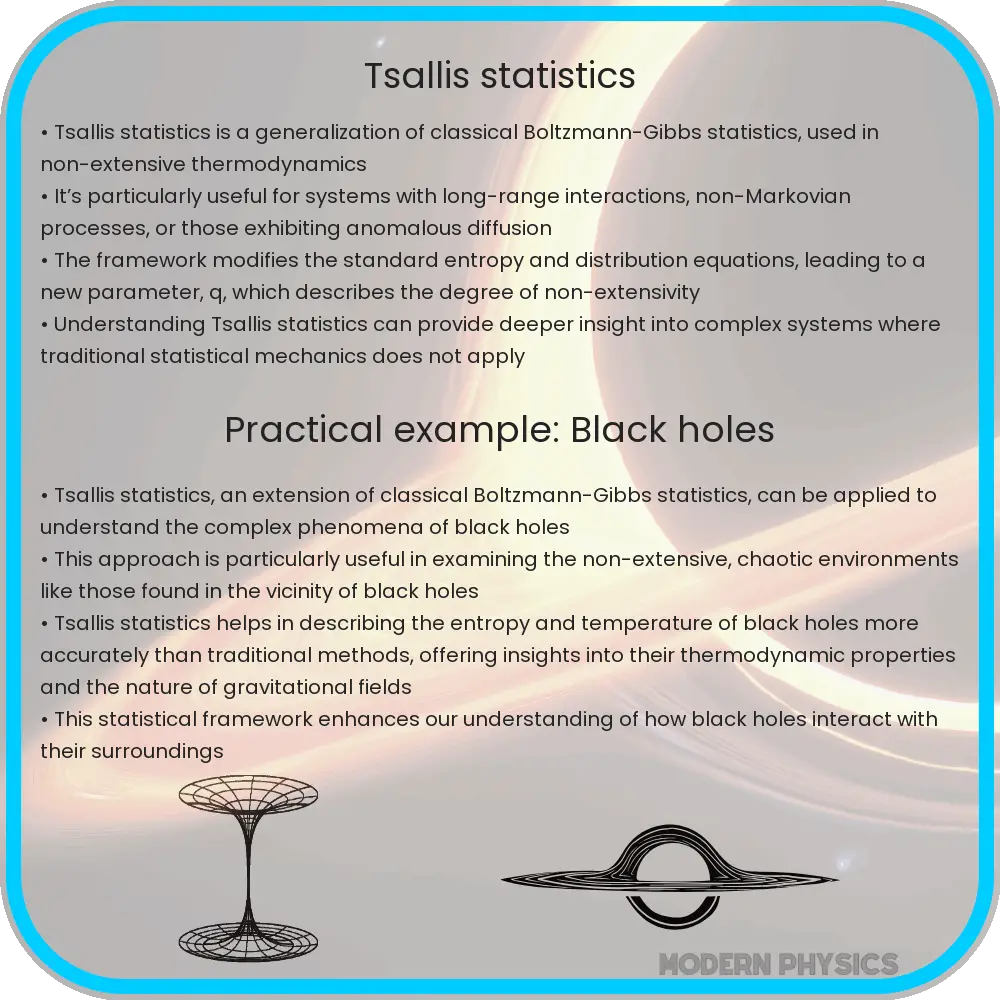Explore the revolutionary Tsallis Statistics: understand non-extensive entropy and its applications in complex systems across various fields.

Tsallis Statistics: Bridging Entropy and Complexity
The realm of statistical mechanics has been traditionally governed by the classical Boltzmann-Gibbs (BG) statistics, which has provided profound insights into systems at or near thermodynamic equilibrium. However, the emergence of Tsallis statistics, formulated by Constantino Tsallis in 1988, marks a significant leap in understanding complex systems that deviate from this equilibrium. This new statistical framework is particularly adept at handling systems characterized by long-range interactions, memory effects, and multifractal structures.
Understanding Non-Extensive Entropy
At the heart of Tsallis statistics lies the concept of non-extensive entropy, which is a generalization of the BG entropy. The Tsallis entropy, denoted as \( S_q \), is given by the equation:
Sq = kB \frac{1 - \sum_{i}p_{i}^{q}}{q - 1} (1)
where \( k_B \) is the Boltzmann constant, \( p_i \) represents the probabilities of the microstates, and \( q \) is the entropic index. This entropic index is a measure of the degree of non-extensivity of the system, with \( q = 1 \) reducing to the classical BG entropy.
Non-Extensivity and Complex Systems
One of the most intriguing aspects of Tsallis statistics is its ability to describe non-extensive systems. In traditional thermodynamics, the property of extensivity implies that system properties like entropy are proportional to the system size. However, in many real-world scenarios, especially in complex systems, this linearity does not hold. Tsallis entropy encapsulates these anomalies through its non-linear nature, thereby providing a more accurate description of the underlying dynamics of complex systems.
Applications in Diverse Fields
The implications of Tsallis statistics extend far beyond the confines of theoretical physics. It has found applications in a wide range of disciplines, including cosmology, quantum mechanics, biology, and even economics. The flexibility of the Tsallis framework allows for a better understanding of phenomena like turbulence in fluids, movement patterns in living organisms, and market dynamics in financial systems.
In summary, Tsallis statistics opens a new window into the study of complex systems, challenging and extending the classical notions of statistical mechanics. Its non-extensive entropy offers a versatile tool for analyzing systems that operate far from equilibrium, thereby enriching our understanding of the intricate world of complexity.
Deepening Understanding with Tsallis Statistics
Tsallis statistics not only provides a framework for analyzing non-extensive systems but also introduces new perspectives in the study of critical phenomena and phase transitions. The classical BG statistics often struggle to accurately describe the critical behavior in systems with long-range interactions. Tsallis’ formulation, with its unique approach to entropy and probability distributions, fills this gap. It enables the exploration of the edge of chaos, a critical point where systems transition between order and disorder, a concept crucial in fields like neuroscience and ecology.
Role in Information Theory and Machine Learning
Another significant application of Tsallis statistics is in the realm of information theory and machine learning. The generalized entropy concept has led to the development of novel algorithms in data analysis and artificial intelligence. These algorithms are especially effective in dealing with datasets that exhibit non-standard distributions, common in real-world scenarios. By harnessing the power of Tsallis entropy, machine learning models can potentially uncover patterns and correlations that elude traditional models based on BG statistics.
Challenges and Future Directions
Despite its successes, the implementation of Tsallis statistics is not without challenges. One of the main difficulties lies in determining the appropriate value of the entropic index \( q \) for a given system. This index, which dictates the degree of non-extensivity, varies from system to system and requires careful calibration. Moreover, the theoretical underpinnings of Tsallis statistics, particularly in relation to the fundamental principles of thermodynamics, continue to be a subject of active research and debate within the scientific community.
Conclusion
Tsallis statistics, with its groundbreaking approach to entropy and complexity, has revolutionized our understanding of non-extensive systems. It challenges the traditional paradigms of statistical mechanics, offering a more nuanced and flexible framework for analyzing a wide array of complex phenomena. From the intricacies of quantum systems to the unpredictability of financial markets, Tsallis statistics provides a powerful tool for deciphering the complexity inherent in the natural world. As research progresses, it holds the promise of unveiling deeper insights into the dynamics of systems that operate beyond the boundaries of classical equilibrium thermodynamics.
